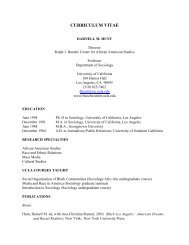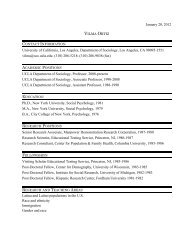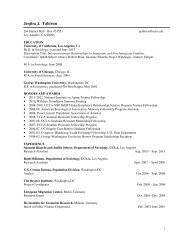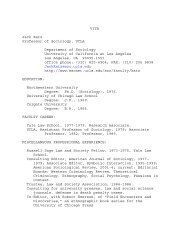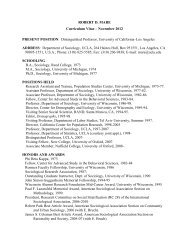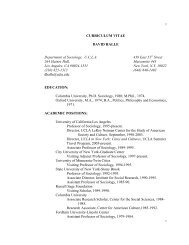William G. Roy - UCLA's Department of Sociology
William G. Roy - UCLA's Department of Sociology
William G. Roy - UCLA's Department of Sociology
Create successful ePaper yourself
Turn your PDF publications into a flip-book with our unique Google optimized e-Paper software.
<strong>William</strong> G. <strong>Roy</strong>. Page 4<br />
Published articles:<br />
"Comment les mouvements sociaux font la culture," Forthcoming in Les artistes et la politique.<br />
Terrains franco-américains edited by Violaine Roussel, Saint-Denis, Presses<br />
Universitaires de Vincennes<br />
“What is Sociological About Music?” Forthcoming, Annual Review <strong>of</strong> <strong>Sociology</strong> (with Timothy<br />
J. Dowd).<br />
AChandler, Alfred D.@ Pp. 51-53 in International Encyclopedia <strong>of</strong> Economic <strong>Sociology</strong>, edited by<br />
J. Beckert and M. Zafirovski. London: Routledge, 2006.<br />
AMonopoly and Oligopoly.@ Pp 462-66 in International Encyclopedia <strong>of</strong> Economic <strong>Sociology</strong>,<br />
edited by J. Beckert and M. Zafirovski. London: Routledge, 2006.<br />
AFrom the Chair: Comparative-Historical <strong>Sociology</strong> as an Identity.@ Comparative & Historical<br />
<strong>Sociology</strong>: Newsletter <strong>of</strong> the ASA Comparative and Historical <strong>Sociology</strong> Section. 18<br />
(2006): 1-3.<br />
A>Race Records= and >Hillbilly Music=: The Institutional Origins <strong>of</strong> Racial Categories in the<br />
American Commercial Recording Industry.@ Poetics 32 (2004): 265-79.<br />
Excerpt from Socializing Capital: The Rise <strong>of</strong> the Large Industrial Corporation in America. Pp.<br />
433-456 in The New Economic <strong>Sociology</strong>: A Reader, edited by Frank Dobbin, Princeton<br />
University Press (2004).<br />
AAesthetic Identity, Race, and American Folk Music.@ Qualitative <strong>Sociology</strong>. 25 (2002): 459-<br />
469.<br />
AHow Many Logics <strong>of</strong> Collective Action?@ with Rachel R. Parker-Gwin. Theory and Society.<br />
28 (1999): 203-237.<br />
ACorporate Law and the Organization <strong>of</strong> Property in the U.S.: The Origin and Institutionalization<br />
<strong>of</strong> New Jersey Corporation Law.@ with Rachel R. Parker-Gwin. Politics and Society. 24<br />
(1996): 111-136.<br />
AThe Organization <strong>of</strong> the <strong>of</strong> the Corporate Class Segment <strong>of</strong> the American Capitalist Class at the<br />
Turn <strong>of</strong> the this Century.@ pp. 139-163 in Bringing Class Back In edited by Scott G.<br />
McNall, Rhonda F. Levine, and Rick Fantasia. 1991. Boulder, Colo.: Westview Press.<br />
AFunctional and Historical Logics in Explaining the Rise <strong>of</strong> the American Industrial<br />
Corporation.@ Comparative Social Research. Vol 12 (1990): 19-44. (Reprinted in Mark<br />
Granovetter and Richard Swedberg. The <strong>Sociology</strong> <strong>of</strong> Economic Life. Second Edition.<br />
(2001). Westview Press.)<br />
AInterlocking, Directorates and Communities <strong>of</strong> Interest Among American Railroad Companies,




